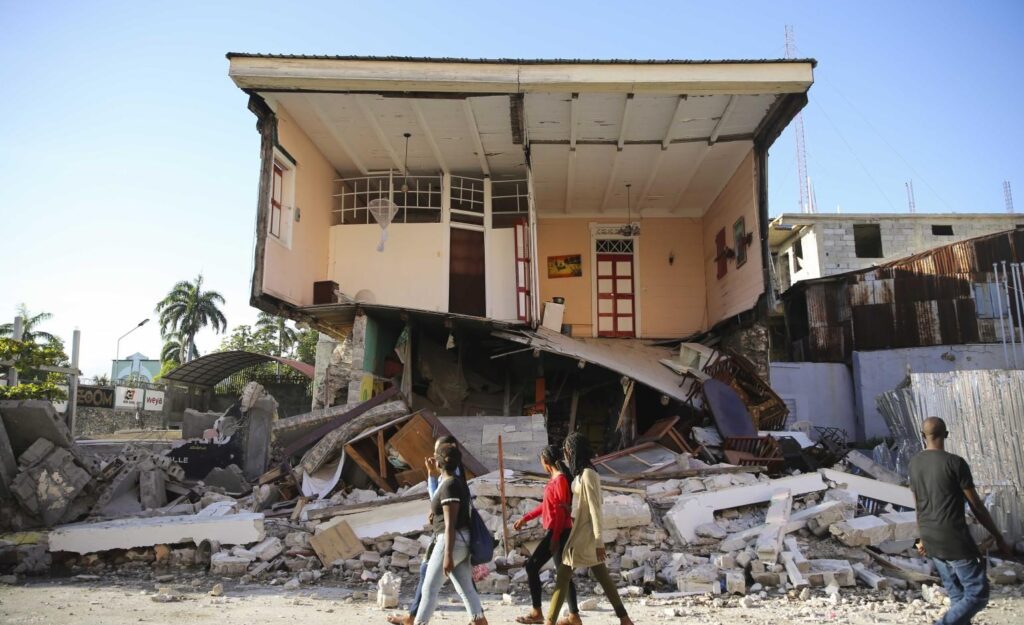LES CAYES — Doctors and aid workers rushed today to get flights to southwestern Haiti ahead of a looming storm, with hospitals in the devastated area unable to cope with casualties from a major earthquake that killed at least 1,297 people in the Caribbean nation.
Saturday’s 7.2 magnitude quake brought down thousands of homes and buildings in the deeply impoverished country, which is still recovering from another major temblor here 11 years ago and the assassination of its president, Jovenel Moise, last month.
The areas in and around the city of Les Cayes – some 150 km (93 miles) west of the capital Port-au-Prince – suffered the biggest hit, putting enormous strain on local hospitals, some of which were badly damaged by the quake.
Prime Minister Ariel Henry said there was no time to lose.
“From this Monday, we will move faster. Aid provision is going to be accelerated,” he wrote on Twitter. “We will multiply efforts tenfold to reach as many victims as possible with aid.”
Port-au-Prince airport today was bustling with medics and aid workers, with domestic and private charter flights filled with humanitarian teams and supplies headed south.
In addition to damage to some roads in the area from the earthquake, access to Les Cayes has been complicated by months of political turmoil in Haiti, which has left gangs in control of key access routes to parts of the country.
The United Nations called for a “humanitarian corridor” here to enable aid to pass through gang-held territories.
At Les Cayes airport, a steady stream of ambulances arrived, bringing the severely injured from nearby areas, a Reuters witness said. Casualties were carried on stretchers to small aircraft and a U.S. Coast Guard helicopter to be taken to Port-au-Prince, where hospital services remained more intact.
Jeanette Pierre, whose cousin died in the earthquake, stood near the runway tarmac next to her 71-year-old father Pierre Ender, who was on an intravenous drip with bandages on his two broken legs, and her mother, who had one broken leg.
Each was caught under falling masonry when their house collapsed during the quake.
“We went to the hospital with the other victims, but there weren’t enough doctors to attend to us,” said their daughter. “Now we’re hoping to get to Port-au-Prince for treatment.”
With the telephone network down in more remote areas and thousands injured, the death toll is expected to rise further, aid workers and officials said. In difficult-to-reach villages, many houses were fragile and built on slopes vulnerable to landslides, said Alix Percinthe of the ActionAid charity.
The disaster also threw into confusion plans to hold presidential elections in November to draw a line under the political confusion here since Moise was assassinated on July 7.
HEAVY RAINS FORECAST
Aid workers were hurrying to beat the arrival of Tropical Depression Grace, which early on Monday was moving west-northwest off the southern coast of Hispaniola, the island that Haiti shares with the neighboring Dominican Republic.
According to projections by the U.S. National Hurricane Center (NHC), Grace will pass right through areas directly hit by the quake, and could douse them with up to 15 inches (38 cm) of rain in some places, presenting a risk of flash floods and mudslides.
Skies over Port-au-Prince were still clear early on Monday.
Many Haitians who lost their homes have been sleeping outdoors, many traumatized by memories of a magnitude 7 quake here 11 years ago that struck far closer to Port-au-Prince, the capital, killing more than 200,000 people, according to the United Nations.
Thousands of people sleeping in the streets would be exposed to rains amid a rising risk of waterborne diseases, such as cholera, according to Jerry Chandler, the head of Haiti’s Civil Protection Agency.
“We do have a serious issue,” Chandler said yesterday.
He said boats and helicopters were being used to bring in aid, but the government was working to establish safe access by road. Initial supplies have made it through by land.
In Jeremie, to the northwest of Les Cayes, doctors were forced to treat injured patients on hospital stretchers underneath trees and on mattresses by the side of the road.
Churches, hotels and schools were also seriously damaged or ruined in the quake. Some 13,694 houses were destroyed, the civil protection agency said, and the toll could rise further.
In Les Cayes, a seafront town of some 100,000 people, rescuers in red hard hats and blue overalls pulled bodies from the tangled wreckage of one building, as a yellow mechanical excavator nearby helped to shift the rubble.
Nearby countries rushed to send food and medicines. Colombia dispatched search and rescue personnel. Mexican President Andres Manuel Lopez Obrador said on Monday morning his country would continue to provide support to Haiti.
The United States sent vital supplies and deployed a 65-member urban search-and-rescue team with specialized equipment, said Samantha Power, the administrator of the United States Agency for International Development (USAID).
Meanwhile, the humanitarian crisis in Haiti provoked this reaction on U.S. Virgin Islands social media this morning.
“The U.S. needs to stop making them,” Jonnie King said on Facebook from St. Thomas “They have suffered enough. Does the Clinton needs money? They got billions to built 500 homes, where are the homes?”
“The problem is the buildings are poorly built,” Richie Lewis said. “If you look carefully there is not enough to no steel in those concrete structures in judgement if a car crash into one of those building it could take down the entire building.”
— REUTERS
Writing by Dave Graham; Editing by Daniel Flynn and Jonathan Oatis
Our Standards: The Thomson Reuters Trust Principles.

